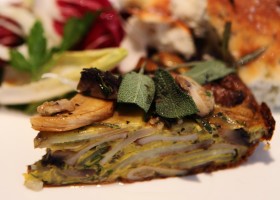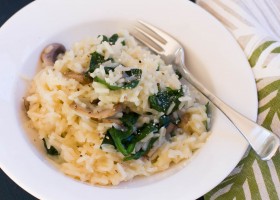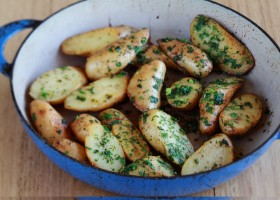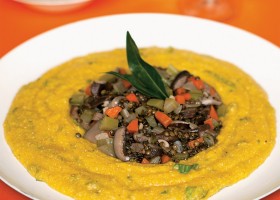Ingredients
- 2 flat mushrooms, stems trimmed
- 1 Tbsp unsalted butter
- 2 bunches sage
- salt flakes and freshly-milled black pepper
- 300g button mushrooms, sliced
- 2 cloves garlic, minced
- ¼ cup extra virgin olive oil
- ½ bunch parsley, finely chopped
- 2 eschalots, finely sliced
- 2 potatoes, peeled and finely sliced
- 6 free range eggs
- 150ml cream
- 2 Tbsp grated pecorino
Sage, mushroom and potato tortilla

Sage barely survives the winter, reduced to a woody skeleton of easily-broken stems. Its few cold-weather leaves are small and flavourless, and many gardeners give up on its future, concluding that the plant has succumbed to the long cold season.
But in a matter of weeks, or days it seems, the plant transforms itself from dullard to darling, sprouting effortlessly in bouquets of highly-fragrant leaves crowned with delicate purple flowers.
And for the gourmet, this is an annual rite of passage. The first soft grey-green leaves are plucked and tossed into myriad dishes. The camphor and pine-notes of the sage (reminiscent of rosemary but with deeper subtlety and more lingering taste) fill the house invitingly.
Stuffed into rolled pork roasts, or shredded through near-naked pasta with a just a sprinkling of cheese and olive oil, sage is complex and grounding. Some herbs are simply perfumes that provide top-note character to complete a meal – marjoram and chives are good examples, but sage is more robust and purposeful containing both earthy base flavours as well as the more typical accentuations.
To really celebrate sage, though, you need to offer it a platform upon which to shine, coupling it with more delicate ingredients like potatoes and mushrooms. In this context, sage can display its glorious ranges of culinary talents, a feast for the nose as well as the palate!
Method
Preheat oven to 180°C. Put the mushrooms in a lined roasting pan and top with the butter and half the sage leaves. Season with salt and pepper. Bake for 30 minutes, until well-softened. Set aside to cool, then slice finely.
Sauté the button mushrooms and garlic in half the olive oil in a frying pan over a moderate heat for 10 minutes, until well-softened, then mix in the parsley and set aside to cool.
Mix most of the mushrooms in a large bowl, reserving some for garnish. Fry the potatoes in the remaining olive oil, until just softened, then combine with the mushrooms and eschalots.
Whisk the eggs, cream and pecorino in a second bowl then pour over the mushroom mixture and stir gently to combine. Season with salt and pepper, then pour into a skillet and cook over a low heat until beginning to set around the edges. Place the skillet in the oven and bake for 10 minutes until set. Turn out, then garnish with the reserved mushrooms and remaining sage leaves.
Tips and Tricks
Hard cheeses store excellently in the freezer. Grate fully and keep in a sealed plastic bag – cheese can be used in cooking straight from frozen.
Carefully remove any greening part of the potato with a knife- it can be toxic when consumed in large amounts and will taint the flavour of your dish. Many potatoes can also be eaten with their skin on – where possible, scrub rather than peeling so as not to lose good edible flesh and to reduce waste.
Note: Substituting fresh herbs for dried herbs can be a great option if you don’t have any fresh to hand or you know you can’t use it all. A general rule is to use the 3:1 ratio—use 3 times more fresh than dried.







